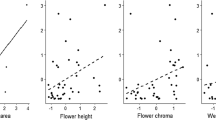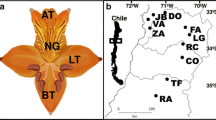Abstract
Knowledge about plant–plant interactions for pollinator service at the plant community level is still scarce, although such interactions may be important to seed production and hence the population dynamics of individual plant species and the species compositions of communities. An important step towards a better understanding of pollination interactions at the community level is to assess if the variation in floral traits among plant species explain the variation in flower visitation frequency among those species. We investigated the relative importance of various floral traits for the visitation frequency of all insects, and bumblebees and flies separately, to plant species by measuring the visitation frequency to all insect-pollinated species in a community during an entire flowering season. Visitation frequency was identified to be strongly positive related to the visual display area and the date of peak flowering of plant species. Categorical variables, such as flower form and symmetry, were important to the visitation frequency of flies only. We constructed floral similarity measures based on the species’ floral traits and found that the floral similarity for all species’ traits combined and the continuous traits separately were positively related to individual visitation frequency. On the other hand, plant species with similar categorical floral traits did not have similar visitation frequencies. In conclusion, our results show that continuous traits, such as flower size and/or density, are more important for the variation in visitation frequency among plant species than thought earlier. Furthermore, differences in visitation frequency among pollinator groups give a poor support to the expectations derived from the classical pollination syndromes.


Similar content being viewed by others
References
Aizen MA (2001) Flower sex ratio, pollinator abundance, and the seasonal pollination dynamics of a protandrous plant. Ecology 82:127–144
Bosch J, Retana J, Cerda X (1997) Flowering phenology, floral traits and pollinator composition in a herbaceous Mediterranean plant community. Oecologia 109:583–591
Campbell DR, Motten AF (1985) The mechanism of competition for pollination between two forest herbs. Ecology 66:554–563
Caruso CM (1999) Pollination of Ipomopsis aggregata (Polemoniaceae): Effects of intra- vs. interspecific competition. Am J Bot 86:663–668
Conner JK, Rush S (1996) Effects of flower size and number on pollinator visitation to wild radish, Raphanus raphanistrum. Oecologia 105:509–516
Cresswell JE, Galen C (1991). Frequency dependent selection and adaptive surfaces for floral character combinations: the pollination of Polemonium viscosum. Am Nat 138:1342–1353
Dicks LV, Corbet SA, Pywell RF (2002) Compartmentalization in plant-insect flower visitor webs. J Anim Ecol 71:32–43
DNMI (2003) Meteorologisk institutt, Oslo. http://met.no/observasjoner/sogn_og_fjordane/2003/juli/index.html?month. Cited 3 Jan 2005
Duffield GE, Gibson RC, Gilhooly PM, Hesse AJ, Inkley CR, Gilbert FS, Barnard CJ (1993) Choice of flowers by foraging honey-bees (Apis mellifera): possible morphological cues. Ecol Entomol 18:191–197
Dupont YL, Hansen DM, Olesen JM (2003) Structure of a plant-flower-visitor network in the high-altitude sub-alpine desert of Tenerife, Canary Islands. Ecography 26:301–310
Elberling H, Olesen JM (1999) The structure of a high latitude plant-flower visitor system: the dominance of flies. Ecography 22:314–323
Faegri K, van der Pijl L (1979) The principles of pollination ecology, 3rd edn. Pergamon, Oxford
Feinsinger P (1987) Effects of plant-species on each others pollination: is community structure influenced. Trends Ecol Evol 2:123–126
Fenster CB, Armbruster WS, Wilson P, Dudash MR, Thomson JD (2004) Pollination syndromes and floral specialisation. Annu Rev Ecol Evol Syst 35:375–403
Fremstad E (1997) Vegetasjonstyper i Norge. NINA, Trondheim
Glantz SA, Slinker BK (2001) Primer of applied regression and analysis of variance. McGraw Hill, New York
Goulson D (2003) Bumblebees: behaviour and ecology. Oxford University Press, Oxford
Goulson D, Stout JC, Hawson SA, Allen JA (1998) Floral display size in comfrey, Symphytum officinale L. (Boraginaceae): relationships with visitation by three bumblebee species and subsequent seed set. Oecologia 113:502–508
Herrera J (1988) Pollination relationships in southern Spanish Mediterranean shrublands. J Ecol 76:274–287
Inoue K, Maki M, Masuda M (1995) Different responses of pollinating bees to size variation and sexual phases in flowers of Campanula. Ecol Res 10:267–273
Inouye DW, Pyke GH (1988) Pollination biology in the Snowy Mountains of Australia: comparisons with montane Colorado, USA. Aust J Ecol 13:191–210
Jordano P (1987) Patterns of mutualistic interactions in pollination and seed dispersal: connectance, dependence asymmetries, and coevolution. Am Nat 129:657–677
Kandori I (2002) Diverse visitors with various pollinator importance and temporal change in the important pollinators of Geranium thunbergii (Geraniaceae). Ecol Res 17:283–294
Lack AJ (1982) The ecology of flowers of chalk grassland and their insect pollinators. J Ecol 70:773–790
Laverty TM (1992) Plant interactions for pollinator visits: a test of the magnet species effect. Oecologia 89:502–508
Lid J, Lid DT (1994) Norsk flora. Samlaget, Oslo
McCall C, Primack RB (1992) Influence of flower characteristics, weather, time of day, and season on insect visitation rates in three plant communities. Am J Bot 79:434–442
Medel R, Botto-Mahan C, Kalin-Arroyo M (2003) Pollinator-mediated selection on the nectar guide phenotype in the Andean Monkey flower, Mimulus luteus. Ecology 84:1721–1732
Memmott J (1999) The structure of a plant–pollinator food web. Ecol Lett 2:276–280
Meynie S, Bernard R (1997) Pollinator efficiency of some insects in relation to wild species populations of Helianthus L. Agronomie 17:43–51
Ohashi K, Yahara T (1998) Effects of variation in flower number on pollinator visits in Cirsium purpuratum (Asteraceae). Am J Bot 85:219–224
Olesen JM, Jordano P (2002) Geographic patterns in plant–pollinator mutualistic networks. Ecology 83:2416–2424
Pellmyr O (2002) Pollination by animals. In: Herrera CM, Pellmyr O (eds) Plant-animal interactions: an evolutionary approach. Blackwell, Oxford, pp 157–184
Petanidou T, Vokou D (1993) Pollination ecology of Labiatae in a phryganic (east Mediterranean) ecosystem. Am J Bot 80:892–899
Pickering CM (2001) Size and sex of floral displays affect insect visitation rates in the dioecious Australian alpine herb, Aciphylla glacialis. Nord J Bot 21:401–409
Pleasants JM (1980) Competition for bumblebee pollinators in Rocky Mountain plant communities. Ecology 61:1446–1459
Schemske DW, Willson MF, Melampy MN, Miller LJ, Verner L, Schemske KM, Best LB (1978) Flowering ecology of some spring woodland herbs. Ecology 59:351–366
Stanton ML, Preston RE (1988) Ecological consequences and phenotypic correlates of petal size variation in wild radish, Raphanus sativus (Brassicaceae). Am J Bot 75:528–539
Thomson JD (1978) Effects of stand composition on insect visitation in two-species mixtures of Hieracium. Am Midl Nat 100:431–440
Thomson JD (1981) Spatial and temporal components of resource assessment by flower-feeding insects. J Anim Ecol 50:49–59
Thomson JD (1982) Patterns of visitation by animal pollinators. Oikos 39:241–250
Totland O (1993) Pollination in alpine Norway: flowering phenology, insect visitors, and visitation rates in two plant-communities. Can J Bot 71:1072–1079
Totland O, Matthews I (1998) Determinants of pollinator activity and flower preference in the early spring blooming Crocus vernus. Acta Oecol 19:155–165
Waser NM, Fugate ML (1986) Pollen precedence and stigma closure: a mechanism of competition for pollination between Delphinium nelsonii and Ipomopsis aggregata. Oecologia 70:573–577
Waser NM, Chittka L, Price MV, Williams NM, Ollerton J (1996) Generalization in pollination systems, and why it matters. Ecology 77:1043–1060
Wilkinson L (2003) SYSTAT 10.0. SPSS Inc, Chigaco
Zar JH (1999) Biostatistical analysis. Prentice Hall, New Jersey
Acknowledgements
We thank Sondre Eikås, Vegard Eldholm, Peter Greve, Maria Collett Knagenhjelm, Torkjell Solbraa, and Knut Fredrik φ i for their invaluable field assistance, Luc Boeke for statistical advices, and Anne-Line Bjerknes, Andreas Jürgens, Anders Nielsen and two anonymous reviewers for very constructive comments on the manuscript. We also thank Christen Knagenhjelm for letting us use the meadow in Rudsviki. The study is financed by the Norwegian Research Council through the Biodiversity-program (project number 154185/720).
Author information
Authors and Affiliations
Corresponding author
Additional information
Communicated by Christian Koerner
Rights and permissions
About this article
Cite this article
Hegland, S.J., Totland, Ø. Relationships between species’ floral traits and pollinator visitation in a temperate grassland. Oecologia 145, 586–594 (2005). https://doi.org/10.1007/s00442-005-0165-6
Received:
Accepted:
Published:
Issue Date:
DOI: https://doi.org/10.1007/s00442-005-0165-6




